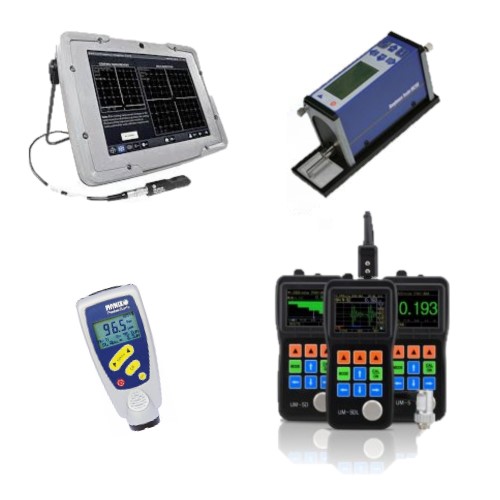What is NDT?
Non Destructive Testing
Under the common term NDT, which stands for Non-Destructive Testing, there are numerous concepts such as inspection, visual inspection, Non-Destructive Evaluation, ultrasonic testing, magnetic and penetrant testing, eddy current equipment, and much more.
Here you can find explanations and definitions of the various topics.
NDT Methods
Read more about the specific NDT methods in our NDT Handbook/Wiki below:
What is Condition Monitoring?
It is a different situation during the maintenance phase, where we talk about using non-destructive testing methods for condition monitoring.
Here, knowledge of material degradation processes—within a given environment and for a given material in a particular construction—determines which testing method(s) should be used for describing the condition. Moreover, the acceptance and rejection criteria are rarely well-defined in advance, as they depend on factors such as the design, the degree of wear, and the current operating conditions.
As a result, rejection criteria in many cases must be established based on an interaction among multiple parameters, which must be identified both qualitatively and quantitatively using different condition monitoring methods.
During the condition monitoring phase, it is often necessary to combine several testing methods in order to describe the condition of a material or component.
Thus, in the maintenance phase, it is not possible to choose the method(s) of control and acceptance/rejection criteria before having a clear, operationally and metallurgically justified understanding of which degradation mechanisms might be in play and what effect they could have on the material in question.
What is Production Control?
The development of non-destructive testing methods began years ago, as welding became increasingly common, creating a need to inspect weld quality.
Non-destructive testing methods such as X-ray (radiography), ultrasonic testing, penetrant testing (capillary testing), and magnetic particle testing were adopted to detect defects arising during or as a result of the manufacturing processes. These testing methods are collectively referred to as NDT – Non Destructive Testing.
As manufacturing control requirements increased over time, both method selection and procedures as well as acceptance and rejection criteria became highly standardized and are today largely defined by national and international norms and standards.
What is Quality Control?
Quality control is an important part of the use of non-destructive testing methods in the NDT industry. The purpose of quality control is to ensure that the products manufactured or used meet the requirements and specifications set for them.
Quality control covers the planning, execution, and documentation of the non-destructive tests that must be performed on a material or component. Quality control also entails ensuring that the testing methods used are validated, calibrated, and traceable to international standards.
Quality control is an ongoing process aimed at ensuring that non-destructive testing methods are reliable, accurate, and reproducible. Quality control helps improve productivity, efficiency, and safety in the NDT industry.
Historical NDT Events
-
1854 Hartford, Connecticut: After a violent boiler explosion that killed 21 people and injured 50 more, the state of Connecticut enacted a law requiring annual inspection (visual in this case) of boilers.
-
1880 - 1920 The "Oil and Whiting" method for detecting cracks was used by the railroad industry on larger steel parts. Diluted oil was applied to the part, which was then coated with a white layer that dried to a powder. Oil seeping out from cracks became visible in the powder, revealing the cracks. This method was the forerunner of modern liquid penetrant testing.
-
1895 Wilhelm Conrad Röntgen discovers X-rays. In his first report, he mentions the possibility of their use for inspection and defect detection.
-
1920 - Dr. H. H. Lester begins developing industrial radiography for metals.
-
1924 — Lester uses radiography to inspect castings before installation in a Boston Edison Company steam power plant.
-
1926 The first eddy current instrument is used for thickness measurement.
-
1927 - 1928 Magnetic induction systems for detecting cracks in railroad tracks are developed by Dr. Elmer Sperry and H.C. Drake.
-
1929 Magnetic particle testing and associated equipment undergo groundbreaking development (A.V DeForest and F.B. Doane).
-
1930 Robert F. Mehl demonstrates radiographic images using gamma radiation from radium, which could penetrate thicker components than the X-ray equipment of the time.
-
1935 - 1940 Penetrant testing (capillary testing) is developed (Betz, Doane, and DeForest).
-
1935 - 1940 Eddy current instruments are developed (H.C. Knerr, C. Farrow, Theo Zuschlag, and Fr. F. Foerster).
-
1940 - 1944 Ultrasonic testing methods are developed in the USA by Dr. Floyd Firestone.
-
1946 First neutron radiography is produced by Peters.
-
1950 The "Schmidt Hammer," also called the "Swiss Hammer," is invented. It becomes the world’s first patented non-destructive testing method for concrete.
-
1950 J. Kaiser introduces acoustic emission as an NDT method.


_copy (1) (1)/assets/images/header/trustpilot.png)
